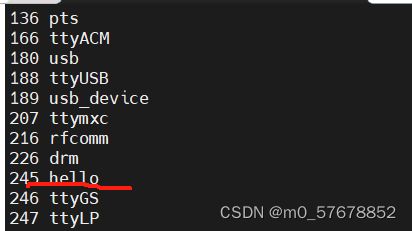编写hello驱动程序
hello的驱动编写
编写驱动程序的步骤
1.确定主设备号,也可以让内核分配
2.定义自己的 file_operations 结构体
3.实现对应的 drv_open/drv_read/drv_write 等函数,填入 file_operations 结构 体
4.把 file_operations 结构体告诉内核:register_chrdev
5.谁来注册驱动程序啊?得有一个入口函数:安装驱动程序时,就会去调用这 个入口函数
6.有入口函数就应该有出口函数:卸载驱动程序时,出口函数调用unregister_chrdev
7.其他完善:提供设备信息,自动创建设备节点:class_create,
代码
驱动代码
hello_drv.c
#include 测试程序
hello_drv_test.c
#include \n" , argv[0]);
printf(" %s -r\n", argv[0]);
return -1;
}
/* 2. 打开文件 */
fd = open("/dev/hello", O_RDWR);
if (fd == -1)
{
printf("can not open file /dev/hello\n");
return -1;
}
/* 3. 写文件或读文件 */
if ((0 == strcmp(argv[1], "-w")) && (argc == 3))
{
len = strlen(argv[2]) + 1;
len = len < 1024 ? len : 1024;
write(fd, argv[2], len);
}
else
{
len = read(fd, buf, 1024);
buf[1023] = '\0';
printf("APP read : %s\n", buf);
}
close(fd);
return 0;
}
Makefile
# 1. 使用不同的开发板内核时, 一定要修改KERN_DIR
# 2. KERN_DIR中的内核要事先配置、编译, 为了能编译内核, 要先设置下列环境变量:
# 2.1 ARCH, 比如: export ARCH=arm64
# 2.2 CROSS_COMPILE, 比如: export CROSS_COMPILE=aarch64-linux-gnu-
# 2.3 PATH, 比如: export PATH=$PATH:/home/book/100ask_roc-rk3399-pc/ToolChain-6.3.1/gcc-linaro-6.3.1-2017.05-x86_64_aarch64-linux-gnu/bin
# 注意: 不同的开发板不同的编译器上述3个环境变量不一定相同,
# 请参考各开发板的高级用户使用手册
KERN_DIR = /home/book/100ask_imx6ull-sdk/Linux-4.9.88
all:
make -C $(KERN_DIR) M=`pwd` modules
$(CROSS_COMPILE)gcc -o hello_drv_test hello_drv_test.c
clean:
make -C $(KERN_DIR) M=`pwd` modules clean
rm -rf modules.order
rm -f hello_test
obj-m += hello_drv.o
KERN_DIR = /home/book/100ask_imx6ull-sdk/Linux-4.9.88
用make命令编译后,将编译出的hello_drv.ko 和hello_drv_test传给板子
板子操作
- 安装驱动:insmod hello_drv.ko
2.lsmod : 查看已经安装的驱动,可以看到hello_drv已经安装
3.cat /proc/devices查看设备节点,看到hello节点已经被创建,这是再hello_drv.c文件里创建的节点,具体看hello_int函数
5.删除驱动程序 rmmod hello_drv


